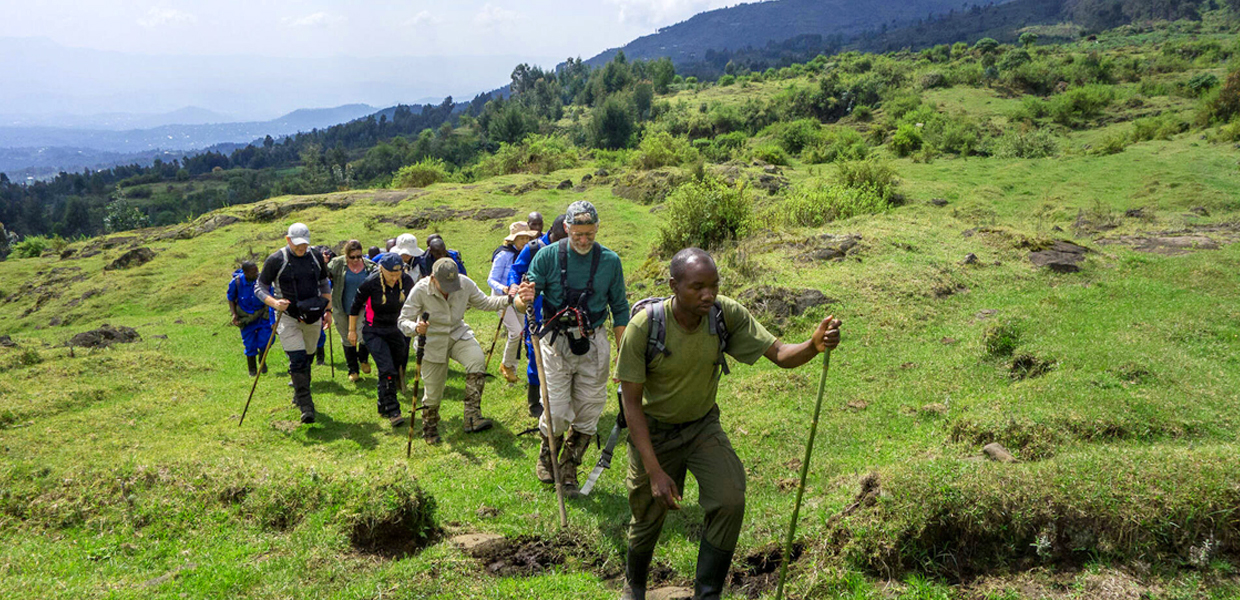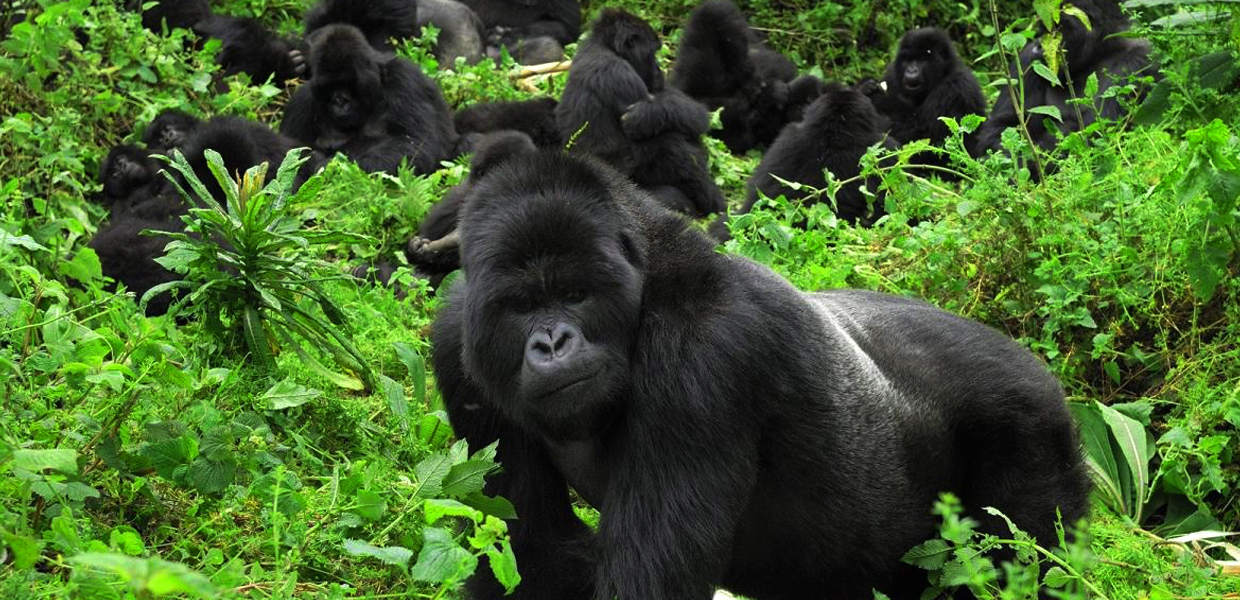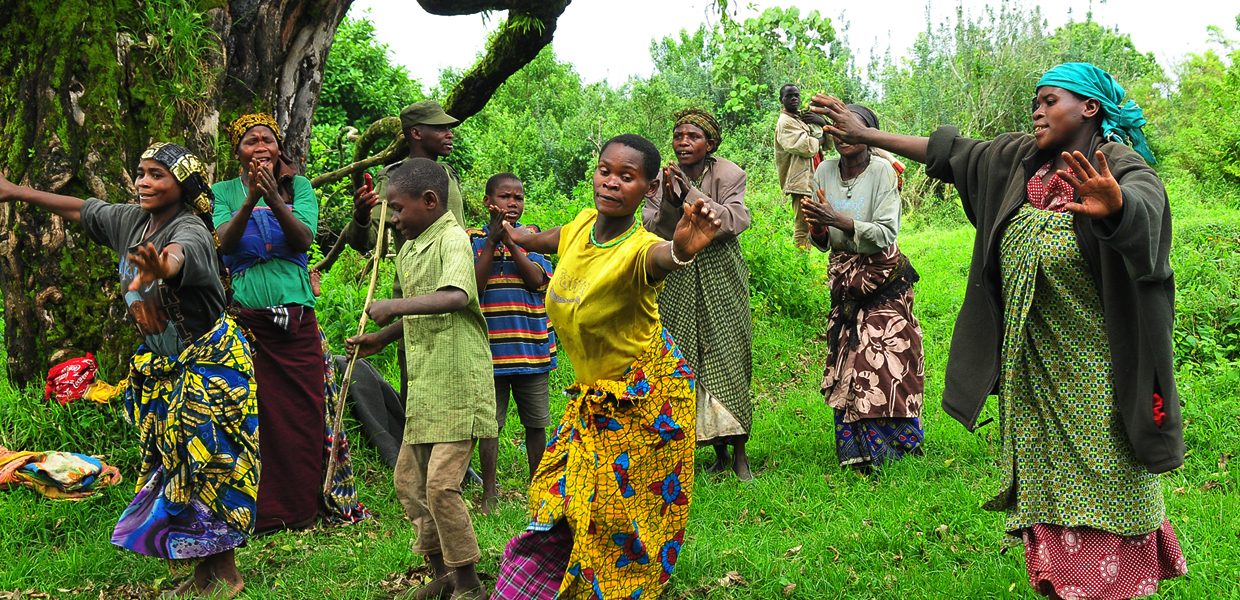
The experience of venturing deep into the jungles of Volcanoes National Park, in the Northern Province of Rwanda with an expert Ranger guide, to track the endangered mountain gorillas in their natural habitat is second to none. Before the first rays of the golden sun even strikes the earth, as birds begin singing sweet melodies, the adventure of meeting face to face with the Giant Apes in the wild begins. Trekkers have to arise early to meet at the Park Headquarters for a mandatory briefing that will see them walk through the jungles without interrupting other residents of the Park and encounter many attractions along the way.
Send enquiry for this experience
The up-close and personal encounters with these Giant Apes as they do about their daily routines without disturbance are always scrupulously managed, with well-trained and enthusiastic trackers and Ranger guides leading small groups (of not more than 8 visitors) up the slopes of Virunga Mountains covered with varying vegetation types (Bamboo being the commonest) to spend one of the most unforgettable and magical one hour, just a few meters from these Great Apes.
Gorillas, being the largest living primates are distributed across the African Continent (mostly in the Equatorial African rainforests) in the Democratic Republic of Congo, Uganda, Rwanda, Angola, Gabon, Equatorial Guinea, Cameroon, Nigeria, the Republic of Congo (or Congo Brazzaville) and the Central African Republic. Generally, there are two species of gorillas (Western and Eastern gorillas) which are sub-divided into four sub-species- Cross River Gorillas, the western lowland gorillas, Mountain gorillas, and Eastern lowland gorillas. The Mountain gorillas are the ones you will be tracking in Rwanda’s Volcanoes National Park.
Mountain Gorilla Families in Rwanda
From the recent count of 2018, there are about 1063 mountain gorillas and about 604 of them are found in the Virunga Conservation Area (comprising Rwanda’s Volcanoes National Park, Uganda’s Mgahinga Gorilla National Park, and Democratic Republic of Congo’s Virunga National Park) and the rest are found in Bwindi Impenetrable National Park. This population has however increased, thanks to the combined efforts of Governments (UWA, RDB, and ICCN), Conservation organizations, and surrounding local communities.
There are presently about 20 gorilla families in Rwanda, but 12 are fully habituated for tracking while the rest are habituated for research studies. This implies only 96 gorilla permits can be issued each day for Volcanoes National Park (8 gorilla permits/visitors for each habituated gorilla family). Each of the gorilla families is comprised of at least one silverback (mature male identified by the silver-grey saddle on the back to the hips), alongside adult females and several offsprings. These mountain gorillas are monitored from time to time and Protected by armed Ranged attached to the Rwanda Development Board and each family (of mountain gorillas) comes into contact with visitors for strictly one hour each day.
The 12 habituated gorilla families available for tracking in Volcanoes National Park include Muhoza, Karisimbi (or Susa B), Bwenge, Sabyinyo, Kwitonda, Agashya, Hirwa, Ugenda, Susa A, Amahoro, Igisha, and Umubano.
Send enquiry for this experience
Gorilla Permits Cost for Rwanda
It is now clear that only 8 gorilla permits are issued for each habituated gorilla family and this makes encounters as private and uninterrupted as possible. However, this means that only 96 gorilla permits will be issued each day, against the hundreds of visitors that visit Volcanoes National Park each day. For this reason, it is always advised to book gorilla permits at least 6 months to one year in advance. Permits go for only $1500 per person per trek. However, you are entitled to a 30% discount on gorilla permits if you also visit Nyungwe or Akagera National Park and spend 3 days. This means you will be buying gorilla trekking permits at $1050 per person per trek.
How mountain gorilla tracking adventures are done in Rwanda
Mountain gorilla tracking in Rwanda begins with a gathering at Kinigi Park Headquarters at 7:00 am for a briefing and later allocation into a gorilla family. Allocation of visitors to gorilla families is based on a number of factors that include age, level of physical fitness, and personal interests. This is followed by the 20-minute transfer to the different trailheads.
Guided treks to the different gorilla locations take anywhere between 30 minutes and 4 hours or more, often getting to altitudes of 2500 to 4000 meters above sea level. For this reason, it is always advisable to hire porters who offer assistance in carrying your backpacks and offer a helping hand as you hike to higher altitudes. When encountered, a sigh of relief will be seen in the faces of most trekkers and afterward, one hour is spent viewing and photographing these Giant Apes as they go about their daily routines.
Send enquiry for this experience
Guidelines to be followed by tracking mountain gorillas in Rwanda
The guidelines to be followed while tracking mountain gorillas are usually issued during a briefing at the Park Headquarters and they include;
- Maintaining a distance of 8 meters from the Giant Apes while viewing or photographing them.
- Spend a maximum of one hour with these Great Apes.
- Don’t visit the mountain gorillas when sick, especially with flu or cough because these Giant Apes are susceptible to these diseases.
- Avoid touching the mountain gorillas and even when they get closer, move back slowly without drawing attention.
- Eating, smoking, and drinking in the presence of mountain gorillas are strictly prohibited.
- Avoid imitating mountain gorilla calls or faces as it might annoy them hence charging.
- A maximum of 8 visitors are allowed to visit a mountain gorilla family each day.
- Don’t make noise while tracking because you will scare away other creatures in the Park especially primates and birds which would otherwise spice up your gorilla trekking experience.
The best time for mountain gorilla tracking in Rwanda
There is no such thing as the “best time” for mountain gorilla tracking in Rwanda because Volcanoes National Park is open throughout the year and the mountain gorillas are seen any time of the year. However, experiences vary according to season. For visitors that track in the dry season (June to September and December to February), chances of rains are lower (but not inevitable) hence be prepared for anything. Because the chances of rain are lower, trails are drier and less challenging.
The wet season (March to May and October to November) comes with lots of rains (although not all day, instead in the mornings and nights), thus making trails muddier and slippery hence more challenging.
What to carry for mountain gorilla tracking in Rwanda
The golden rule about packing is being prepared for anything and therefore, make sure that you carry a rain jacket regardless of season, a warm sweater, hiking boots, gardening gloves, a camera, and waterproof covering, binoculars, a backpack, reusable water bottle, insect repellant, breathtaking safari pants, long-sleeved shirt, first aid kit, sunglasses, and others.
How to get to Volcanoes National Park for your mountain gorilla tracking adventure
Volcanoes National park in the Northern Province of Rwanda is easily accessible by air and road. It is only two and a half hour’s drive from Kigali International Airport via a smooth 116-kilometer distance with breathtaking views of rolling hills and lush countryside. This Park is also reachable by a 30-minute scenic helicopter flight from Kigali International Airport.



